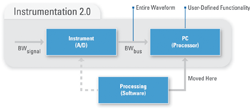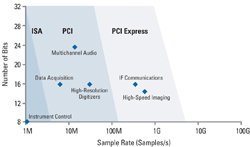Instrumentation 2.0: PCIe’s and Multicore’s impact
Significantly higher-speed data communications and processing capability offer new choices in test system configuration
BY CRAIG ANDERSON
National Instruments
Austin, TX
http://www.ni.com
Web-based applications, including Google, Wikipedia, and YouTube, have helped change the Web from a model in which a small number of entities produce content for mass consumption to a model where each user customizes and defines his or her own content consumption. This new Web paradigm has been dubbed Web 2.0.
At the same time, our world has become increasingly software oriented. The features of devices we use every daysmart phones, set-top boxes, and even automobilesare to a large extent defined, and sometimes dynamically redefined, by their embedded software.
Modern instrumentation architectures take advantage of these two macro trendsuser-defined customization and increasing software focusso you can completely customize your application.
The concept of user-defined instrumentation isn’t new; in fact, it’s been around for more than two decades in the form of virtual instrumentation. However, the technologies driving these trends have now matured to create a tipping point. Similar to the Web, the difference is distinct enough from the traditional approach to be called Instrumentation 2.0.
Traditional approach
Thus traditional instrumentation can be retro-dubbed Instrumentation 1.0. To view the traditional approach from today’s vantage point, we need to define a few terms.
The first of these terms is signal bandwidth, BWsignal , which is the bandwidth of the digitized signal in terms of Mbytes/s. For example, if a signal is sampled at 100 MS/s with 14-bit (call it 2-byte) resolution, the BWsignal is 100 x 2, or 200 Mbytes/s.
The other term is bus bandwidth, or BWbus , which is simply the throughput of the bus in Mbytes/s.
With traditional standalone instruments, if signal bandwidth is greater than bus bandwidth (BWsignal > BWbus ), you need onboard memory and/or onboard processing. The cost of that additional hardware can add up.
This is why, in the traditional instrumentation approach, measurement capabilities are vendor-defined and implemented in firmware inside the box (see Fig. 1 ). Only the final measurements, as defined by the vendor, are sent over to the PC, and you have no control over the actual data for signal processing or custom measurements.

Fig. 1. With Instrumentation 1.0, if signal bandwidth exceeds bus bandwidth, measurements must be made with instrument firmware.
The increasing need for user-defined test systems that address unique test requirements calls for a new approach to instrumentation.
Architecture redefined
High-throughput communication buses, such as PCI Express, are shifting the instrumentation paradigm. When bus bandwidth exceeds signal bandwidth, you can send the entire waveform over the communication bus (see Fig. 2 ) to a PC Card; of course, the card’s processor must then be able to keep up with all the incoming data.

Fig. 2. With Instrumentation 2.0, if bus bandwidth exceeds signal bandwidth, you can fully customize measurements in the software.
Multicore processors promise to deliver the processing power needed for an increasingly broad set of applications. Such a method obviates the need for onboard signal processing and memory in most applications.
The real power of this redefined architecture lies in the fact that you now can completely customize your application. Rather than settle for a preset result, you can create user-defined measurements in the software.
As previously indicated, the two key technologies driving this change in instrumentation are high-speed data buses, such as PCI Express, and multicore processing. Using advances in these technologies, you can address applications once requiring proprietary solutions with cutting-edge Instrumentation 2.0 products.
High-speed data bus
With a software-oriented user-defined instrumentation approach, the focus is on the PC card and its associated technologies. Because you send signals acquired with I/O hardware to the PC over a data bus, it is critical for the bus technology to keep up with the ever-increasing I/O bandwidth and speed.
With a theoretic transfer limit of 8 Mbytes/s, the ISA bus provided sufficient bandwidth for the traditional approach to instrument control. When PCI (132 Mbytes/s) came along, engineers could use the Instrumentation 2.0 approach for many new applications, including audio measurements and high-speed data acquisition.
PCI Express (see Fig. 3 ), with its dramatic increase in bus bandwidth, can in turn power a whole new class of applications, including RF communications test and high-speed digital test.

Fig. 3. The highest throughput/bandwidth commercial communications bus, PCI Express opens up Instrumentation 2.0 applications.
PCI Express delivers the highest throughput of any commercial communications bus. Available in x1, x4, x8, and x16 links, PCI Express provides 200 Mbytes/s of usable throughput per lane with very low latency. The x1 and x4 options, the most common for instrument-class hardware, provide 200 and 800 Mbytes/s, respectively, of dedicated throughput. The x16 link, which provides 3.2 Gbytes/s of usable throughput, is now commonly used in new PCs for plug-in video cards.
Multicore improvements
While you can successfully transfer signals from high-speed I/O hardware to the PC card, it must have enough processing power to process all the transferred data. Thus, the latest advancement in processor technologyplacing multiple cores, or computing engines, within a single processoris critical to Instrumentation 2.0.
Both Intel and AMD have released dual-core processors, and future processors will expand the number of cores to four or more. In fact, Intel is targeting to deliver an 80-core processor in four years.
Unfortunately, finding increased processing power is not as simple as buying the latest CPU. Software applications must be optimized so that they can capitalize on optimizing multicore performance. Writing multithreaded applications in text-based programming languages, such as C, is nontrivial for most design and test engineers and requires expertise in the semantics of creating and managing the threads and passing data between them in a thread-safe way.
Multitasking operating systems such as Windows XP and Vista, as well as multithreaded applications such as National Instruments’ LabVIEW software, can take full advantage of the new parallel processing capability introduced by multicore technology.
NI LabVIEW let users take full advantage of multicore processors because its graphical programming environment naturally lends itself to parallel programming. In LabVIEW, two loops that do not share a data dependency automatically execute in separate threads, and thread management details are lifted from the developer.
1.0 versus 2.0?
The reality is most design and test engineers use a combination of Instrumentation 1.0 and 2.0 architectures in solving problems.
Although Instrumentation 1.0 architectures are typically vendor defined and limit customization, they do not require an external processing element. Most Instrumentation 1.0 equipment has a tactile front panel with knobs and buttons, making it a good option for some interactive benchtop measurements such as debugging an analog circuit.
An Instrumentation 2.0 approach holds clear advantages when the benchtop measurement task
is repetitive and benefits from automationrequires using multiple instrumentsrequires analysis not predefined by the vendor.
In each of these situations, a software-based approach gives you the flexibility to define your system in a way that meets your own unique application needs.
Web Referral: Get more information on instrumentation at http://electronicproducts-com-develop.go-vip.net/testmeasure.asp ■
Advertisement
Learn more about National Instruments





